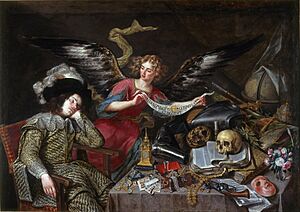The Gentleman's Dream facts for kids
The Gentleman's Dream is a famous painting from the 1650s. It is also known as The Knight's Dream or Disillusion with the World. The painting was created by a Spanish artist named Antonio de Pereda. Today, you can see this artwork at the Real Academia de Bellas Artes de San Fernando in Spain. It has been part of their collection since 1816.
Contents
What is a Vanitas Painting?
The Gentleman's Dream is a type of art called a "vanitas" painting. A vanitas painting reminds us that life is short and that earthly things like money or power are not forever. These paintings often show symbols of death, time passing, and the things people value in life. They encourage viewers to think about what is truly important.
Symbols in Vanitas Art
Vanitas paintings use many symbols to share their message. Here are some common ones:
- Skulls and bones: These are strong reminders of death.
- Clocks or hourglasses: These show that time is always moving and cannot be stopped.
- Candles: A burning candle can mean life, and a snuffed-out candle means death.
- Bubbles: Bubbles are beautiful but burst quickly, showing how fragile life is.
- Flowers or fruit: These can look lovely but will soon wilt or rot, showing decay.
- Books or instruments: These represent knowledge or pleasure, which also fade away.
Who Was Antonio de Pereda?
Antonio de Pereda was an important Spanish painter. He lived from 1611 to 1678. Pereda was known for his religious paintings and also for his still-life works. Still-life paintings show objects like fruit, flowers, or household items. He often included deep meanings in his art, just like in The Gentleman's Dream.
Pereda's Style of Painting
Pereda painted during a time called the Spanish Golden Age. This was a period when art, literature, and culture were very strong in Spain. His paintings often used strong contrasts between light and shadow. This style is called chiaroscuro. It helps to make the figures and objects in his paintings stand out.
Understanding The Gentleman's Dream
This painting shows a young knight or gentleman asleep. He is surrounded by many objects that tell a story about life, time, and death.
What the Painting Shows
Let's look closely at what is in the painting:
- The Sleeping Gentleman: He is dreaming, perhaps about the things he wants in life.
- An Angel: An angel is shown above the gentleman. The angel points to a banner.
- The Banner's Message: The banner has words in Latin: "Aeterne pungit, cito volat et occidit". This means "Eternally it stings, swiftly it flies and it kills." This message is a warning about how quickly life passes and how easily things can end.
- Symbols of Wealth and Power: Around the gentleman, you can see things like coins, jewelry, and weapons. These represent the riches and power that people often seek.
- Symbols of Time and Death: There are also objects like a skull, an hourglass, and a snuffed-out candle. These remind us that time passes and death comes to everyone.
The Painting's Message
The Gentleman's Dream is a powerful reminder. It tells us that even if we gain wealth or power, these things are temporary. The painting encourages us to think about what truly matters in life, beyond material possessions. It suggests that focusing on spiritual values might be more important than chasing worldly success.
Where to See the Painting Today
The painting is located in the Real Academia de Bellas Artes de San Fernando in Madrid, Spain. This museum has a wonderful collection of Spanish art from different periods.
See also
 In Spanish: El sueño del caballero (Pereda) para niños
In Spanish: El sueño del caballero (Pereda) para niños


